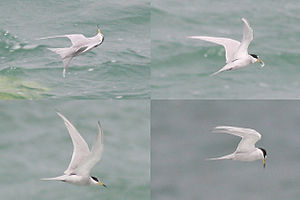Peruse tern
| Peruse tern | ||||||||||
|---|---|---|---|---|---|---|---|---|---|---|

Peruse tern ( Sternula lorata ) |
||||||||||
| Systematics | ||||||||||
|
||||||||||
| Scientific name | ||||||||||
| Sternula lorata | ||||||||||
| ( Philippi & Landbeck , 1861) |
The Peruvian tern ( Sternula lorata ) is a species of bird from the family of the tern (Sternidae). It occurs on the coasts between central Ecuador and northern Chile .
features
The Peruvian tern reaches a size of 22 to 24 centimeters. The forehead, throat and chin are white. The hood is black. A black rein runs between the eyes and the beak. In non-breeding adult birds, the hood shows white lines. The rest of the plumage is mainly light gray, but slightly lighter on the underside. The legs are yellow. The beak is yellow with a black tip.
Occurrence
The distribution area of the Peruvian tern extends to the west coast of South America between central Ecuador and northern Chile. Currently only nine breeding colonies from Chile and four from Peru are known.
habitat
The Peruvian tern breeds on sandy beaches and sand dunes, often more than 100 to 200 m away from the high tide line, as well as in dry stone deserts one to three kilometers inland.
Way of life
The main diet of the Peruvian tern consists of small fish, including the Peruvian anchovy ( Engraulis ringens ), and Antarctic krill . Like other terns, it hovers over the sea and prey on the food animals when immersed in the water. The breeding seasons within the colonies are staggered and extend from August to February. Mating groups after the breeding season can be seen between April and July. The Peruvian tern nests in small, loose groups (from 3 to a maximum of 25 nests). The clutch consists of one or two eggs that are incubated for 22 to 23 days. However, usually only one young is raised. The light gray and beige coloring of the eggs and chicks offers a good camouflage against the preying of predators such as peregrine falcons , Andean jackals and Andean skunk .
Existence and endangerment
In the 1990s, the Peruvian tern was still classified as “not endangered” (least concern) with a population of 5,000 pairs. Between 1997 and 2007, however, the population declined by more than 50 percent, mainly due to the decline in swarms of anchovies in the Humboldt Current, the disruption of breeding colonies by beach vehicles and the destruction of the breeding grounds due to the construction of slum towns, summer houses and roads is due. Today BirdLife International estimates the population at 1,000 to 2,500 individuals and has classified the species as "endangered" since 2005.
Systematics
The type specimen was shot in 1851. In 1861 the Peruvian tern was scientifically described by Rudolph Amandus Philippi and Christian Ludwig Landbeck under the binomial Sterna lorata . When the tern was revised in 2005, the Peruvian tern was placed in the genus Sternula .
literature
- Josep del Hoyo , Andrew Elliot, Jordi Sargatal : Handbook of the birds of the world. Volume 3: Hoatzin to Auks. Lynx Edicions, Barcelona 1996, ISBN 84-87334-20-2 .
- Carlos B. Zavalaga et al .: Current status of Peruvian Terns Sternula lorata in Perú: threats, conservation and research priorities from Bird Conservation International. Cambridge University Press. February 19, 2009
- Carlos B. Zavalaga et al .: The Breeding Biology of the Peruvian Tern (Sternula lorata) in Peru . In: Waterbirds . The Waterbird Society. 2008.